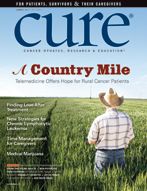Publication
Article
CURE
Non-Physician Practitioners Playing Larger Roles in Cancer Care
Author(s):
In the face of a shortage of oncologists, non-physician practitioners are playing larger roles on cancer-care teams.
America's population is aging, and that includes its oncologists. As a result, as the number of cancer patients and survivors expands, retirements are draining the pool of oncologists available to treat them.
According to a 2007 study commissioned by the American Society of Clinical Oncology (ASCO), demand for oncology services is expected to rise 48 percent between 2005 and 2020, yet due to retirements and a limited influx of new oncologists, the supply of those services is expected to grow by just 14 percent. “This translates into a shortage of 9.4 to 15.0 million visits, or 2,550 to 4,080 oncologists — roughly one-quarter to one-third of the 2005 supply,” according to the study that appeared in the Journal of Oncology Practice.
The health care system is helping to fill that gap — as recommended in the study — by putting portions of oncology care into the hands of non-physician staff members: nurse practitioners (NPs), physician assistants (PAs) and oncology clinical pharmacists.
Nurse Practitioners and Physician Assistants
What should patients know about this shift?NPs and PAs handle everything from new patient intake to follow-up appointments. Many will see patients, evaluate labs, order chemotherapy, provide support services, perform procedures and order medications, depending on state regulations.
Elizabeth Prechtel Dunphy, an advanced practice nurse in oncology at the University of Pennsylvania, has seen how the utilization of NPs translates to the patient as an increase in flexibility and accessibility of care, which, in turn, allows for improved quality of care, potentially resulting in better patient outcomes — although this idea needs more study. “Oftentimes, a physician is pulled in many different directions, and the continuity (that NPs provide) is important to many patients,” Dunphy says. “At this significant time in their lives, having someone to help guide them is very comforting.”
Most NPs and PAs enter the oncology specialty directly after graduating from a master’s program at an accredited school. While most of these programs focus on primary care, some students receive additional training or certification in oncology, either during their initial coursework or in separate programs after they earn their degrees.
Even without widespread oncology-specific training, however, the use of non-physician practitioners (NPPs) is sparking positive results, according to a 2011 survey by ASCO of physicians, non-physician practitioners (NPPs) and patients connected with 226 oncology practices.
In most of the surveyed practices, NPPs saw patients on their own, but with a physician present in the building, and the majority of patients understood that they were seeing non-physician practitioners. The overall satisfaction score of patients with their NPPs was 92.5 percent; physicians reported an 80 percent satisfaction rate with the arrangement, and NPPs were 78 percent satisfied.
Oncology Clinical Pharmacists
Practices that allowed NPPs to work with all their physicians and see a variety of patients reported a 19 percent increase in productivity over practices that restricted their NPPs to working with specific physicians.In recent years, cancer treatment has shifted toward an increased reliance on oral medications. This shift has resulted in the oncology clinical pharmacist stepping out from behind the desk and directly into patient care.
“Classically, the pharmacist is someone who is more behind the scenes, and we are trying to be more front and center in patient care,” says R. Donald Harvey, director of phase 1 clinical trials at Winship Cancer Institute of Emory University, in Georgia.
Working in collaboration with treatment teams, pharmacists are helping patients to understand the effects of their medications on their overall health — how they interact with other medicines and the kinds of lifestyle choices that may maximize or minimize the success of the treatments. “In order for us to have the most impact on patient outcomes, we need to be directly conversing with patients to pick the right drugs and help them manage their treatment,” Harvey says.
Oncology pharmacists are increasingly making rounds with physicians to see patients in clinical and treatment settings, managing drug therapies and serving as conduits between those dispensing the medications and care teams.
From his office that is centrally located in the clinical trials unit, Harvey has been witness to the positive result of the pharmacist’s hands-on approach.
“(It) brings a lot of value and perspective to cancer care, providing direct education to patients and providers as to what to expect and how to manage side effects,” Harvey says. “In the end, patients win."






